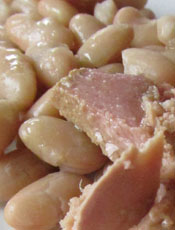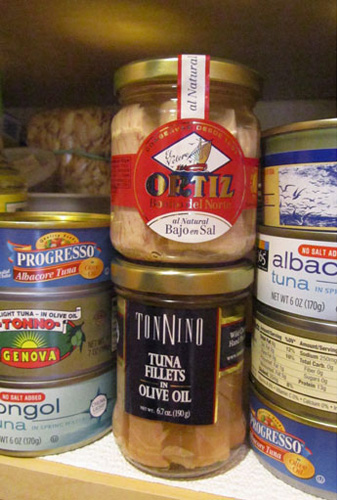Canned Tuna 101
As summer staggers to an end, it's a good time to check our pantries. Besides the fact that a change in season means a change in how we cook, I'm sure I'm not alone in losing track of what's sitting in the recesses of a cabinet or the back of the freezer.
For those of us who live where winter can be harsh and inconvenient, it helps to have the makings of a pantry dinner on hand so when we come home late on a cold and messy night, a take-out menu won't be the only option.
As for many of you, my pantry is small so I must make strategic choices. But I always have canned tuna. My preference is for light tuna packed in olive oil. I like its taste and texture and nearly every recipe in which I use canned tuna I also use olive oil so there's no problem with letting a little of the oil from the can get into the dish. And I like how light tuna is softer than white. However, canned tuna is a complicated ingredient to buy.
Some tunas, especially bluefin, are under siege by overfishing, especially by fishermen who serve the Japanese sushi market. But other tuna species, of which there are dozens, are also at risk. Tongol is often processed, canned, and labeled as "light tuna." According to the Monterrey Bay Aquarium Seafood Watch, tongol should also be avoided unless it is wild and line caught, and preferably from Malaysia where management protection is well enforced.
Albacore, which is also sold as "white," and skipjack, another species marketed as "light," are considered the best choices, according to Seafood Watch. You can find their listings at MonterreyBayAquarium.org and click on Seafood Watch.
But how can we know what's in our can or jar of tuna? Reading the labels will tell us some of what we want to know, but not necessarily where a fish was caught (although it is highly likely a fish was caught where it was processed and that information is on the label). Some artisanal brands of tuna, such as Spain's Ortiz and Italy's Callipo, make a point about how their fish are caught and its Mediterranean origins.
12 Oz. A Week
A comment about canned tuna and nutrition. As with other fish, canned tuna is high in omega-3 fatty acids, but unlike most other fish it can also be higher in toxins, specifically methylmercury. This has to do with how our big fish -- tuna as well as swordfish, king mackerel, shark and tilefish; but notably not so much smaller fish or shellfish -- intake and metabolize the toxins present in our oceans (pathetic, isn't it, that our pollutants end up in our oceans and become part of our aquatic life). As a result, whether bought in a can, pouch, or glass jar, and regardless if white or light, canned or fresh, tuna should probably not be eaten more than twice a week. The FDA says 12 ounces a week. If you have health issues, maybe you shouldn't have it at all.
I'm not a doctor, nor a nutritionist, but as with any food, you should know your own health and dietary circumstances. Moderation is a good start and education is essential. So choose your ingredients carefully and stock your pantry accordingly.
But for most of us, as an occasional ingredient, canned tuna is a budget-minded, nutritional, versatile, and flavorful choice.
Cooking With Tuna
I have a potent food memory from my first day of my first visit to Italy. Our flight had arrived too early for us to check into our hotel and the concierge had sent us off to a nearby café to wait and have an early lunch. I can close my eyes and see and hear, as if it were an hour ago, a tiny table on the sidewalk on the Via del Corso, city traffic buzzing like the FDR Drive at rush hour. Before me was a glass of rosy pink fruit juice and a small, glossy brioche roll filled with a forkfuls of canned oil-slicked tuna, dressed only with a few capers. Nothing in my life will ever again taste as good as that tuna salad sandwich.
Tuna salad as madeleine? Well, why not. Nearly everyone has a favorite tuna salad. Some like a little dice of celery. Others use a lemon zest or finely minced red onion. Or add sweetness from bits of granny smith apple, or sour from pickles or relish. Or chopped hard-boiled egg (okay; that's probably too much). But for most home cooks, tuna salad includes mayonnaise.
A comment on mayonnaise: While homemade mayonnaise is vastly superior to store bought (see our recipe), Hellman's and Best Foods are both very good. They're also made by the same company and are almost exactly the same -- although some say Best's has more tang. The brand depends upon where in the U.S. you live. The eastern half gets Hellman's and in the west it's Best Foods.
I usually buy Hellman's "Light" version and can scarcely tell the difference in flavor or texture from the "Real." Yet the fat and calorie difference is significant: 90 calories per tablespoon and 15% total fat for the Real versus 35 calories and 5% fat for the Light. However, the "Reduced Fat" is not at all close to being as good. The texture is gummier and its flavor, to my palate, is a bit off. And since you're only saving 10 calories a tablespoon versus the "Light," I say choose Hellman's Light instead.
I like my tuna salad to be simple: If it's for a sandwich I'll add a little celery seed and mayonnaise and prefer the bread to be toasted rye; if tomatoes are in season I will add a slice but otherwise will leave things unadorned. If I'm making tuna salad to stuff a beefsteak tomato or paired with a traditional potato salad, I make my tuna without any mayo, tossing only a few tiny capers and a little freshly cracked black pepper with the flaked, oily fish.
According to The Tuna Council, Americans eat 1 billion pounds of canned, pouched and jarred tuna a year. This translates into 2.7 pounds per person, more than half of which is eaten in sandwiches. But canned tuna is very versatile so if a tuna salad sandwich isn't your idea of a satisfying pantry-sourced dinner, here are other ways to cook with this handy ingredient:
- In Amanda Hesser's The Essential New York Times Cookbook, she shares an easy and inexpensive Olive Oil-Tuna Spread With Lemon and Oregano. In a food processor finely chop 1 large, peeled garlic clove. Scrape down the sides and add: one 6 1/2 oz. can of olive oil-packed tuna with its oil, 4 tablespoons unsalted butter that's been softened, zest of 1 medium lemon, 2 1/2 tablespoons fresh lemon juice (about that from the same lemon you just zested), 1/2 teaspoon dried oregano, a few grinds of black pepper, and a tiny pinch of salt (the tuna is already salty). Process until smooth and creamy and serve with crackers or pita triangles. It can be made in advance and refrigerated but serve at room temperature, giving it a little stir if the oil has separated.
- Tuna Casseroles. Many of us grew up with our mothers making a version with noodles and canned mushroom soup. I've seen many versions that attempt to update this dish but the results often trade dull flavor for their modernity. AllRecipes.com has several versions, including several that try to meet in the middle, although I'd replace any canned vegetables with fresh. If you read through the reviews and comments there are many suggestions for how to customize the flavors.
- Tuna with Pasta. Cook's Illustrated magazine suggests making pantry pasta meals with sauces that use water-packed solid white tuna combined with ingredients that are easy to keep on hand such as lemon zest, capers and parsley; or red peppers, anchovies, garlic and basil; or a Sicilian-styled tuna sauce with raisins, green olives and basil. These combinations can inspire you to create your own favorite combinations that can be mixed and then tossed with a short pasta like penne or fusilli. You can also flake canned tuna into your favorite tomato sauce but it will be best if the sauce is simple so to not overwhelm the tuna flavor.
- Tuna Patties. If you're a fan of salmon or crab cakes, Alise Bauer's wonderful website, SimplyRecipes.com, has a terrific variation. It's also budget minded as two 6 1/2 oz. cans of tuna can generously serve four persons. Go to SimplyRecipes.com and search for tuna for this and other tempting recipes made with canned tuna.
- Tuna and White Beans. I love tuna combined with white cannellini beans. I always have a few cans of these creamy beans on hand and simply drain and rinse a 15 oz. can and combine it in a skillet with a 6 1/2 oz. can of tuna packed in olive oil, using both the tuna and its oil. I warm the combination, adding a small pinch of red pepper flakes and taking care to mush some of the white beans without breaking up the tuna too much. I love this either tossed with pasta or served alongside a hearty green vegetable like kale. If the mixture seems too dry, you can add a little more olive oil or if you have any in your freezer, a little basil pesto.
- Salade Nicoise. While this classic French composed salad -- tuna with green beans, quartered tomatoes, small boiled potatoes, hard boiled eggs, anchovies, and a mustard vinaigrette -- has become popular by being made with pieces of seared fresh tuna, the traditional version is instead made with canned tuna.
- Vitello Tonnato. For the uninitiated, this Italian dish that is best served in the summer, is an unexpected combination of thinly sliced poached veal with a mayonnaise-tuna sauce, both served cold. The piquant, salty and luscious sauce pairs beautifully with the satisfying pieces of moist veal. Marcella Hazan has a brilliant version in her first cookbook, The Classic Italian Cookbook, and in her later Essentials of Classic Italian Cooking which suggests turkey breast as an alternative to the veal. Follow her cooking times carefully because if this expensive cut of veal is overcooked, your dish will resemble dog food (which I learned the hard way).
- Tomato Tonnato. Intrigued by vitello tonnato but don't eat or want veal? See our link to a version by Melissa Clark that appeared in Food & Wine. The acidic tomato makes a wonderful match to the unctuous dressing.
One of my favorite ways to eat canned tuna requires a jar or can of good Spanish or Italian tuna, the kind of souvenir I'm glad to carry home from a trip to Europe, or to splurge on at a good food market like Despana in SoHo or Blue Apron in Brooklyn that sell Mediterranean tuna.
I thinly slice an onion, a white Spanish onion, which is not too acidic nor too sweet. Scatter the onion on a plate alongside pieces of the tuna with some of their own olive oil. With this I'll have chunks of good bread, preferably a Pane Francese, which is soft and pillowy on the inside, with a dark, charcoaled crust. Maybe a little extra olive oil for the bread and black pepper for the tuna. If you have any steamed vegetables, like a tender stalk of broccolini or a few green beans that have been cooked and left to cool to room temperature, this makes a very satisfying supper.

